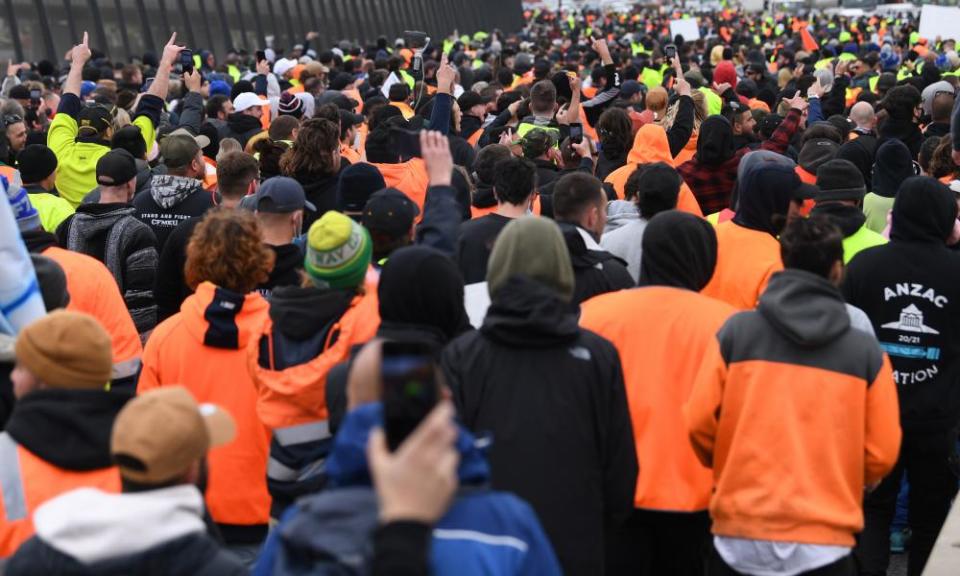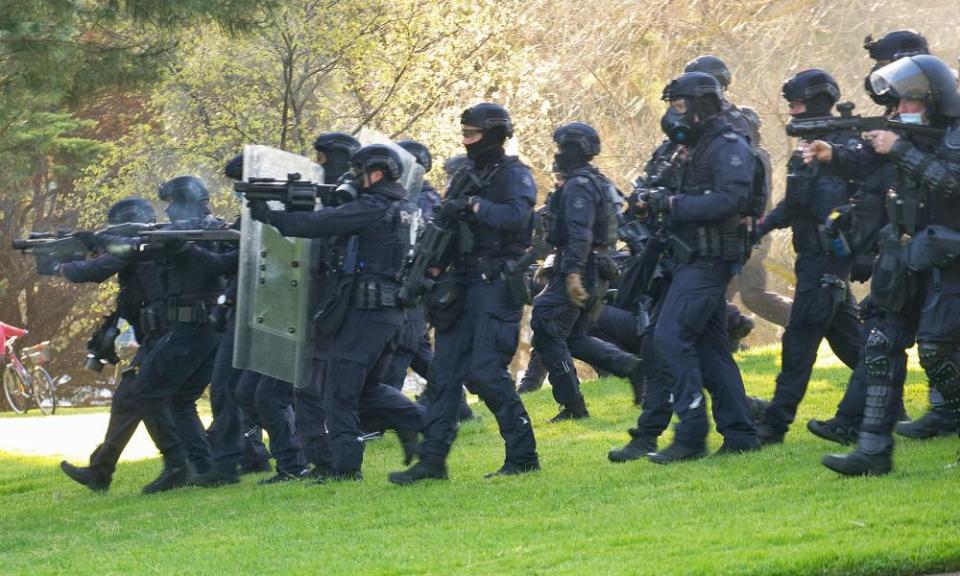Workers’ rights or the far right: who was behind Melbourne’s pandemic protests?

When self-described citizen journalist Rukshan Fernando arrived outside the office of the Victorian Construction, Forestry, Maritime, Mining and Energy Union on Monday morning and began filming, he asked the handful of men milling around outside in hi-vis jackets what they were doing there.
“We’re here for our rights, OK? First of all, everybody has a free choice. We don’t want to have to lose our jobs,” one of them told him.
Another said: “The message needs to go to [Victorian premier] Dan Andrews bro, fuck the vaccine off, we ain’t getting it.”
In just a few hours the gathering would transform into an angry mob. By the middle of the afternoon, hundreds of people – many in those same hi-vis jackets – had shown up at the CFMEU headquarters to confront the union’s powerful secretary, John Setka, over a grab bag of grievances centred on new rules that make Covid vaccinations mandatory for construction workers in Victoria.
Among many construction workers, anger at Covid-era rule changes had been growing for months. As the Age reported this week, much of that frustration had been directed at the union itself, due to a perception that its leadership had not opposed the mandate.
But Monday’s protest – and the week-long series of sometimes violent demonstrations that followed – sparked a parallel debate about the legitimacy of the uprising and the involvement of far-right actors and conspiracy groups in its organisation.
Related: What do we know about the protests in Melbourne, and how did the numbers grow?
Setka said many of the attendees were “neo-Nazis and rightwing extremists” rather than union members. Former federal Labor leader Bill Shorten claimed rightwing groups made up of “man-baby Nazis” had dialled a “rent a crowd”.
But there is little evidence Monday’s initial protest was fuelled by far-right agitators. Among the dozen or so men who gathered outside the CFMEU on Monday was Luke Young, a construction worker who describes himself as “union through and through” and has no association with any of the groups who later flocked to the protests.
Young told Guardian Australia this week he and a handful of colleagues had decided to walk to the CFMEU offices on Monday out of frustration both at the vaccine mandate but also a proposal pushed by the union that would remove rest breaks for workers in exchange for them being paid eight hours for six hours’ work.
“The main reason it all started was people wanted to talk to the union and just get clarification on all this stuff because we feel like it goes against our EBA [enterprise bargaining agreement] and everything we’ve fought for,” Young said.
“There were only five of us that went down. I had spoken to delos [union delegates] on site and they had no clarity or any updates on what the union was doing either. You can’t ring them up because people were getting hung up on if they mentioned anything to do with the vaccine.
“So the only way was to go there and talk to them in person and we decided to do that but we didn’t expect anything like that to happen.” Young told the Guardian he left the protest after Setka attempted to speak to the rally on Monday, and hasn’t been to any of the protests that followed.

Whether Monday’s protest began entirely organically, as Young believes, is unclear. But the presence of Fernando – a wedding photographer who has built a niche as a live-streamer of anti-lockdown protests and denies claims the protests were driven by the far right – suggests there was some pre-planning. He told the Guardian he was alerted to the protest by an Instagram post, though he could not recall who posted it.
In any case, while Monday may have started out as a legitimate expression of frustration, it quickly attracted the attention of the so-called freedom groups that have made a name for themselves protesting against Covid-era restrictions and generally pushing a mass of conspiracy material throughout the pandemic.
By the afternoon, members of one of the largest anti-lockdown groups in Melbourne were encouraging others to attend the rally, and by Tuesday, the same group, led by serial protest organiser Harrison McLean – whose engagement with a number of far-right groups online has previously been revealed by the Guardian – was pushing its own “Workers Rally for Freedom”.
McLean has previously denied being involved in the far right. “I am not Far-Right. I am a Libertarian Populist, and I support Freedom of Speech,” McLean posted under an online username, Dominic, in one forum.
On Tuesday and Wednesday, the long, aimless protests that meandered around Melbourne were littered with figures linked to both the far right and the more conspiracy-driven freedom movement.
The answer to the question of whether the protests were an expression of frustration by a group of legitimate blue-collar workers or a conspiracy-driven swamp of anti-lockdown campaigners, libertarians and neo-Nazis is: both.
“Everyone is asking this question of whether they were Nazis or not,” Dr Kaz Ross, an expert in the far-right and conspiracy-theorist movements in Australia, told the Guardian this week.
“Yes, there were identified and known Nazis among the crowds but, you know, Nazis have jobs too and some of them work in construction.”

Ross told the Guardian she believed the use of the construction workers by the anti-lockdown movement was “opportunistic” – but also a tactic it had frequently used.
“The anti-lockdown types have been looking around trying to latch on to some kind of legitimate-looking group to associate themselves with,” she said. “They tried it with the truckies and they’re trying it with nurses and teachers and aged care workers.”
There’s some evidence the tactic is working. While promises that the protests would continue “every day” had fizzled out by Thursday (another protest planned for Friday also appeared to fail) many were critical of heavy-handed tactics used by the Victoria police to quell the demonstrations.
“Anyone who thinks that it’s a good thing having special operations police looking like they’ve just stepped out of a war zone in Afghanistan walking around Melbourne is nuts,” Ross said.
The protests also gained the explicit and implicit support of some establishment MPs. On Monday, Bernie Finn, the Victorian state Liberal MP who has opposed lockdown measures, expressed support for the anti-vaccine mandate sentiments of some protesters, writing on Facebook: “There is no justification for violence but if any government tried to force medical treatment on me against my will, they’d see a fighting fury.”
Other political groups were more explicit in their support. Members of the fringe libertarian party, the Liberal Democrats, for example, have attended anti-lockdown protests throughout the pandemic, and during the week, figures from the party were highly critical of the police response while also re-tweeting far-right figures such as Avi Yemini.
Whether the protests have broader public support is questionable. After Wednesday’s protest culminated in an extended standoff between demonstrators and police at the Shrine of Remembrance, the Victorian RSL released a statement condemning the protesters for “completely disrespecting the sanctity of this space”. Later, the shrine’s chief executive, Dean Lee, told breakfast TV that protesters had urinated on the memorial.
“There was broken glass, there was rubbish, there was even urination on parts of this sacred monument, which is absolutely appalling,” Lee said.

 Yahoo News
Yahoo News 